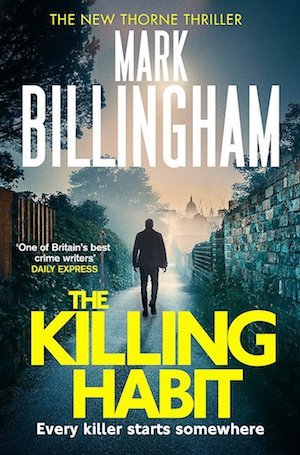
Thorne is certain that a killer who tortures cats, skins them and leaves their bodies for their owners to find on the doorstep will inevitably go further, and may even have killed a person already. But he’s finding it hard to convince anyone in the Met. He finally takes the case to Detective Superintendent Fulton, at his old stomping ground in Kentish Town, to try to convince him to help. With Tanner investigating a different killing, he’s pretty much on his own, the butt of an almost unending string of cat jokes.
The jokes are a bit naff at first but after a few chapters, when Thorne starts meeting the owners of the slaughtered cats, things start to get a bit more serious. The jokes, and Billingham’s constant references to the modern world, serve to make the police officers feel more human. The strength of the DI Thorne series is that it deals with the real world, and real events. If you live in the UK, you’ll most likely have heard of the Croydon Cat Killer, who is believed to have been responsible for the deaths of over 400 animals so far, mainly in London, and who is still on the loose.
Set alongside the animal cruelty is the refugee crisis that has swept across Europe in recent years as DI Tanner investigates the shooting of a refugee on his doorstep. The Killing Habit really is a crime novel that could not exist in another time. The only question is how well a novel that is so firmly entrenched in its era will age, but rereading Billingham’s earlier Thorne novels shows that this isn’t a concern. Here is an author whose works are consistently good, and each one ages like a decent bottle of wine. His books have become great snapshots of their age in the same way that Maj Sjöwall and Per Wahlöö’s Martin Beck police procedurals are a snapshot of Swedish society during the 1970s.
The comparison to the great Swedish police procedurals is an apt one, with the same overworked, intensely human police detectives working their way through crimes that are both heinous and completely believable. As in last year’s Love Like Blood, which dealt with the topic of honour killings, or The Bones Beneath, which took part of its inspiration from the Moors Murderer Ian Brady, the strength of the DI Thorne novels is in the knowledge that all of this could be real. The characters feel real, they laugh and bicker and fret just like real people. The police are human, the victims seem actual, and we even get glimpses into the inner workings of the killers, which along with some of the descriptions of the dead cats will make you feel very uncomfortable. The closing of the novel will please even the most discerning fan of the police procedural, and leave you yearning for more, whether this is your first Tom Thorne thriller or your 15th.
For another contemporary police procedural set in London, why not try Turn a Blind Eye
Little, Brown
Print/Kindle/iBook
£9.99
CFL Rating: 5 Stars